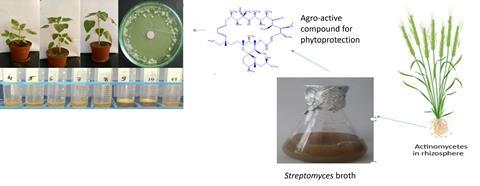Actinomycetes-derived antibiotics and other metabolites could be deployed to mitigate biotic stress in crops, potentially replacing synthetic chemicals as chemo-control agents against phytopathogens, a new review suggests.

The review, ‘Biotic stress alleviation: A sneak peek into the beneficial taxa in rhizosphere’, is published in Biocatalysis and Agricultural Biotechnology.
Corresponding author Professor Olubukola Oluranti Babalola of North-West University in South Africa said plants’ perpetual exposure to continuous climate change results in an evolutionary shift in biodiversity. In most cases, to the detriment of the plant, and one of the collateral damages of climate change to the plants is biotic stress, which limits agricultural productivity.
“The world-class, acceptable biotic stress management approach to achieving high productivity involves the application of synthetic chemicals and disease-resistant varieties. Small farm holders, who are the major contributors to crop productivity worldwide, are under severe pressure to increase nutritious food production and reduce food costs, so a unique management method has to be innovated that matches the small farmholders and consumer’s needs. Hence, the conceptualization of this review to introduce the chemo-control approach,” she said.
Eco-friendly compounds
The thinking behind the review is to create awareness of more eco-friendly and biological-based compounds for plant protection and communicate the use of a direct substitute to bioinoculant application in crop productivity enhancement that uses their by-products.
READ MORE: The Babalola Lab
READ MORE: Fertilizer strategies can shape microbial communities in the rhizosphere
The review also explores the pathways and regulatory cascades that can be modulated to optimize bioinoculant applications and high laboratory scaling of compounds in meeting specific agricultural needs.
“In this area of biotic stress alleviation, an overview of the possible microbes predominant in a stressed crop has been established using maize as a model and their functionalities,” Prof Babalola said.
Role and impact
“The role and impact of these organisms in adaptation and biotic stress alleviation have been evaluated through their gene profiling. Some culturable strains of microbes have also been utilized majorly as bioinoculants for biotic stress alleviation or plant protection.
“Hence, to enhance the application of bioinoculants, biotechnologists are drifting to foster studies with the focal aim of directly applying chemocontrol (by-products of bioinoculant applications) to enhance plant protection.”

Prof Babalola and her team said there are currently few plant-protective metabolites or compounds that have been commercialized for crop protection: “There is a need to produce more as a substitute for synthetic chemical inputs because, in 95% of cases, pathogens would eventually develop resistance with consistent compound applications.”
Plant chemocontrol
Prof Babalola called on agricultural biotechnologists to look into the application of agro-active compounds or metabolites production for plant chemocontrol against pathogens.
“Beyond bioinoculant application, it is time to try a new road map to achieving crop protection in an eco-friendly and sustainable manner,” she said.
“The success of this new study terrain will help discover metabolites producible on a large scale (which is one of the challenges of the study) and applicable in preventing devastating diseases associated with crops, and it will give farmers more alternatives to synthetic chemical inputs.”
Drug discovery
Taking a drug discovery study to the trial level in the medical field takes about 16 years, all things being equal, and involves several players across the science, technology, and medical fields.
“Similarly, this study requires a steady interdisciplinary network involved in ‘hit’ strains selection, enhanced methodology approach for high-yield production, ‘hit’ compound identification, perfect formulation method identification, field application, and ecofriendliness assurance,” Prof Babalola said.
Prof. O.O. Babalola led the conceptualization of this review under the auspices of North-West University, South Africa.







No comments yet